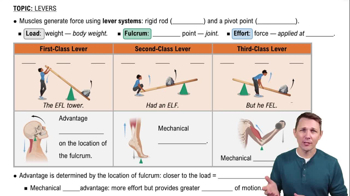Here are the essential concepts you must grasp in order to answer the question correctly.
Lever Systems
A lever system consists of a rigid bar (the lever) that pivots around a fixed point called the fulcrum. Levers are classified into three types based on the relative positions of the load, effort, and fulcrum. Understanding these classifications helps in analyzing how muscles and joints work together to produce movement.
Recommended video:
Types of Levers
There are three main types of levers: first class, second class, and third class. In a first-class lever, the fulcrum is between the effort and the load; in a second-class lever, the load is between the fulcrum and the effort; and in a third-class lever, the effort is applied between the fulcrum and the load. Each type has distinct mechanical advantages and applications in the human body.
Recommended video:
Biceps Brachii and Elbow Joint
The biceps brachii muscle acts on the elbow joint, which is a hinge joint allowing flexion and extension. When the biceps contracts, it applies force to the forearm, which acts as a lever. This action exemplifies a third-class lever system, where the effort (muscle contraction) is applied between the fulcrum (elbow joint) and the load (weight in the hand).
Recommended video:
Structural Joint Classifications



